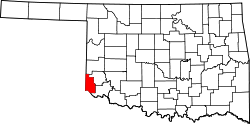History
Following an election on May 22, 1909, Harmon County was created by proclamation of Governor Lee Cruce on June 2. Carved from adjacent Greer County, the new county was named in honor of Judson Harmon, who was Governor of Ohio at the time. [3] The area now covered by Harmon County had been a part of Greer County, Texas until the U. S. Supreme Court awarded it to Oklahoma Territory in 1896. [4]
Another election held September 1, 1909, confirmed Hollis as the county seat. There were two other contestants: the towns of Harmon and Rosser. County offices operated in rented space until a courthouse was built in Hollis in 1926. In 1930, the U.S. Supreme Court ruled that the boundary between Texas and Oklahoma was actually 3,800 feet (1,200 m) farther east than originally believed. It returned the disputed land to Texas, reducing the county's area to its present size. [4]
A railroad built from Altus, Oklahoma to the Texas state line came to Hollis and Gould in 1910. The line was built by the Altus, Wichita Falls and Hollis Railway (later acquired by the Missouri, Kansas and Texas Railroad). [4]
Demographics
Historical population| Census | Pop. | Note | %± |
|---|
| 1910 | 11,328 | | — |
|---|
| 1920 | 11,261 | | −0.6% |
|---|
| 1930 | 13,834 | | 22.8% |
|---|
| 1940 | 10,019 | | −27.6% |
|---|
| 1950 | 8,079 | | −19.4% |
|---|
| 1960 | 5,853 | | −27.6% |
|---|
| 1970 | 5,136 | | −12.3% |
|---|
| 1980 | 4,519 | | −12.0% |
|---|
| 1990 | 3,793 | | −16.1% |
|---|
| 2000 | 3,283 | | −13.4% |
|---|
| 2010 | 2,922 | | −11.0% |
|---|
| 2020 | 2,488 | | −14.9% |
|---|
|
As of the census [11] of 2000, there were 3,283 people, 1,266 households, and 863 families residing in the county. The population density was six people per square mile (2.3 people/km2). There were 1,647 housing units at an average density of three units per square mile (1.2/km2). The racial makeup of the county was 72.65% White, 9.78% Black or African American, 1.13% Native American, 0.18% Asian, 0.03% Pacific Islander, 14.32% from other races, and 1.92% from two or more races. The population was 22.78% Hispanic or Latino.
There were 1,266 households, out of which 30.20% had children under the age of 18 living with them, 55.70% were married couples living together, 9.20% had a female householder with no husband present, and 31.80% were non-families. 29.00% of all households were made up of individuals, and 17.50% had someone living alone who was 65 years of age or older. The average household size was 2.47 and the average family size was 3.03.
In the county, the population was spread out, with 25.90% under the age of 18, 7.90% from 18 to 24, 24.10% from 25 to 44, 21.10% from 45 to 64, and 21.00% who were 65 years of age or older. The median age was 40 years. For every 100 females there were 94.10 males. For every 100 females age 18 and over, there were 89.80 males.
The median income for a household in the county was $22,365, and the median income for a family was $29,063. Males had a median income of $21,530 versus $16,658 for females. The per capita income for the county was $13,464. About 23.50% of families and 29.70% of the population were below the poverty line, including 38.20% of those under age 18 and 19.90% of those age 65 or over.
Population decline
Common to many rural counties in the Great Plains the population of Harmon county has declined steadily since 1930. Between 1930 and 2020, Harmon County lost a greater percentage of its population than any other Oklahoma county, from 13,834 in 1930 to 2,488 in 2020, a decrease of 82.1%. [12]
Economy
Agriculture has been the main component of the county economy. Cotton, wheat and sorghum have been the principal crops. By 1930, farmers had sizable holdings of cattle, poultry, horses, mules, swine, sheep and goats. [4]
This page is based on this
Wikipedia article Text is available under the
CC BY-SA 4.0 license; additional terms may apply.
Images, videos and audio are available under their respective licenses.



